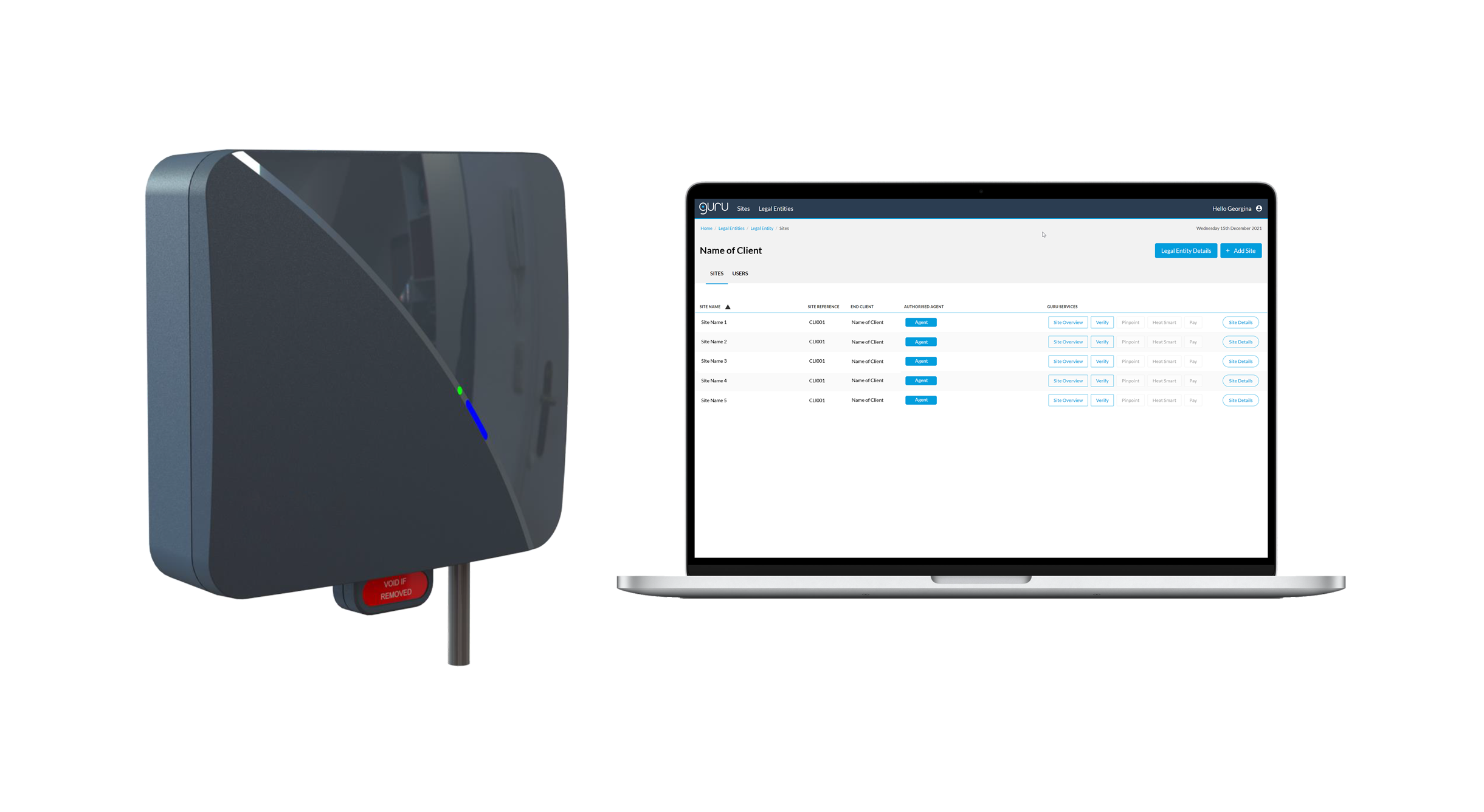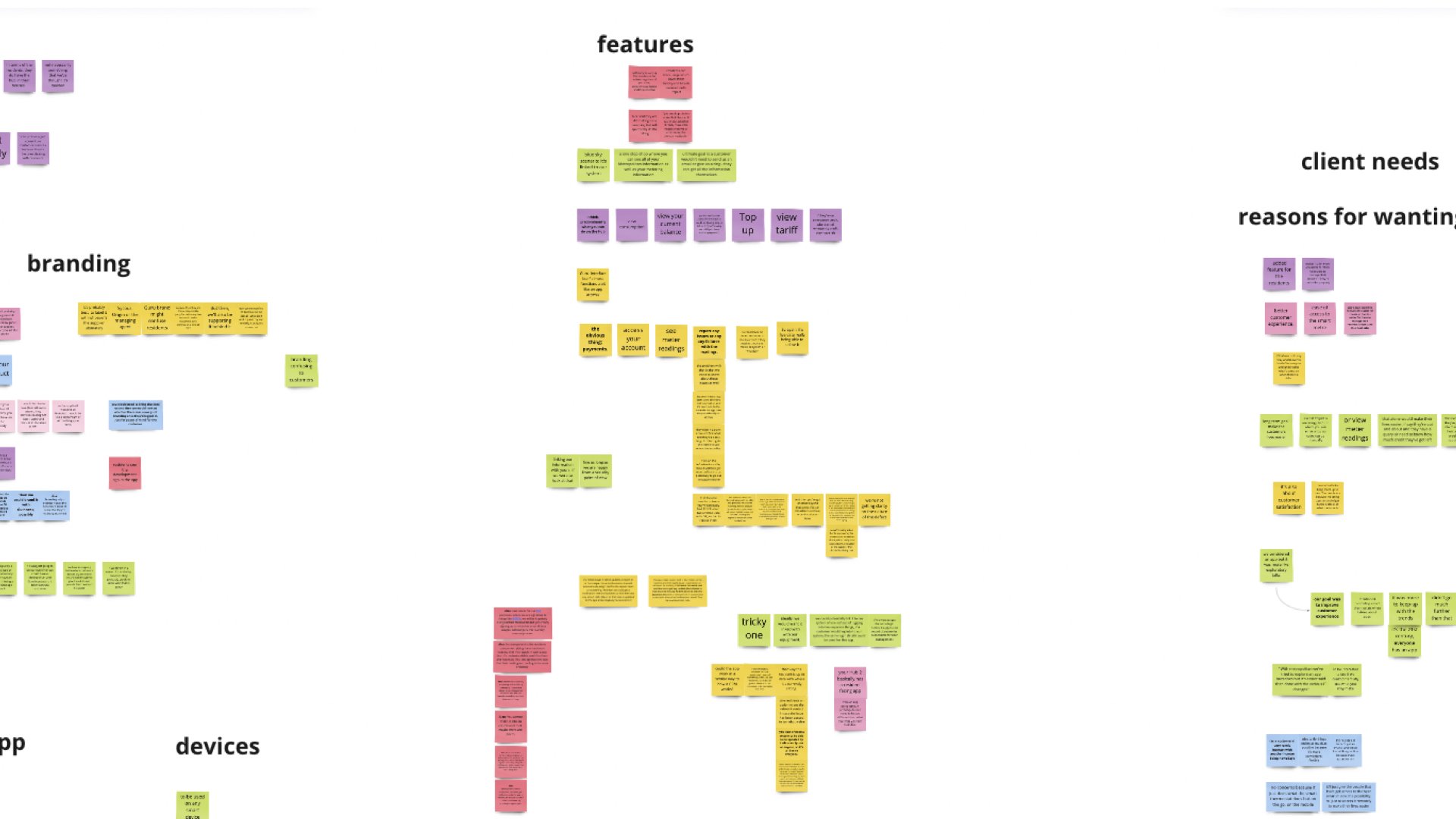Resident-facing mobile app
UX research case study
Overview: This is a proof of concept research project I have led at Guru Systems, a B2B company that creates intelligent technology to make energy systems more transparent, lower cost, and lower carbon. Their clients are housing providers, delivering a variety of services to residents inside their homes.
Objective: Uncover potential opportunities for Guru to develop their first resident-facing mobile app.
The process: Competitor research, stakeholder interviews, survey, user interviews, affinity mapping
My role: UX researcher
Team: Worked alongside a Product Manager
Tools: Otter, Miro, Google Forms
Duration: June-July 2022 (6 weeks)



01. Introduction
Guru Systems is a B2B company that operates in the low-carbon heating space for residential properties. The company provides its clients - such as private developers and social housing providers - with hardware and data analytics platforms for monitoring heating systems, which include heat networks, gas boilers, and heat pumps.
Guru’s product suite meets the following key requirements:
Support intelligent metering and billing: clients obtain accurate meter readings and bill residents accordingly
Remotely control heating devices (essentially a smart thermostat)
Analyse and improve the performance of systems.
The potential for Guru to develop their own resident-facing app had been discussed for several years. This discussion was brought back to the fore for two key reasons:
Growing competitive pressure both in the meter and billing and smart thermostat space
Client requests reported by the Sales team.
02. Research questions & methods
In collaboration with the Product Manager, we identified three critical questions that needed to be addressed in this project. Below is an overview of the research methods I selected to tackle each of these questions.
Question 1
Does Guru need a resident-facing app to keep up with its competitors?
Research method
Competitor research
Reason
Analysing competitors’ resident-facing apps, features, and user experiences, is the best way to identify any gaps in Guru's services and determine if developing a resident-facing app is necessary to stay competitive in the low-carbon heating space.
Question 2
Is the company losing sales because they don’t have one?
Research method
Survey
Reason
Collecting quantitative data. The goal was to obtain measurable and quantifiable insights to identify patterns and trends.
Question 3
What functionalities would be needed for the app to be useful to their clients?
Research method
User interviews
Reason
Gathering qualitative insights and feedback, including specific user needs, preferences, and pain points. User interviews provide an opportunity to explore users' perspectives in depth, enabling the team to tailor the app’s content to meet their requirements.
but first….
03. Stakeholder interviews
Even though the stakeholder interviews didn’t directly address the specific research questions we had outlined, they played a vital role in the research process for several reasons:
Uncovered valuable insights and provided diverse perspectives on the project
Revealed significant common themes that allowed us to fine-tune our research questions, methodologies, and scope
Helped us address potential misalignments and mitigate risks during the course of the project.
Participants
I interviewed Guru’s CEO, CPO, CTO, COO, Senior Client Services Manager, Head of Marketing, and Senior Product Manager. I made sure to include specific role-based questions in order to gain the most relevant insights from each stakeholder.
Process and key findings
After conducting the interviews I documented all the key insights in Miro and went through all the answers, highlighting recurring themes and any significant clashes. Finally, I summarised the key findings.
Interviews documented in Miro
Highlighted common themes and clashes
Summarised key outcomes
04. Competitor research
After working with the Marketing team to identify key competitors within the meter and billing and smart thermostat space, the Product Manager and I created a list of criteria to steer our research. Among other things, I looked at 3 key aspects:
range of features
type of app (web vs native)
hardware required.
I created a template to help me organise the findings as I continued with my research.
After completing the research, I compiled all the features provided by each competitor and categorised them based on common themes. This approach offers the advantage of quickly visualising the types of features available. Some of the categories include payments, energy usage, heating controls, and schedules.
Identified key competitors
Defined key research questions
Created a feature summary
05. Sales insights: survey
The questions I asked all aimed at discovering:
Level of client interest in a resi app
In what area/for which products (meter and billing and/or smart thermostat)
Client requirements for a resi app
Deals lost because we don’t provide a resi app
Participants
The survey was distributed to the entire Sales team, resulting in a robust sample size of 6 participants. While the sample size might seem relatively small, the fact that the entire Sales team participated provides depth and insight into the team's collective perspective.
By involving a cross-section of Sales team members, the survey data reflects a well-rounded representation of the team's insights and perceptions regarding client demand and potential sales impact.
Key findings
Both current and prospective clients ask frequently about a resident-facing app
This is especially true for Guru’s smart thermostat product
There are no clear requirements, other than ‘the usual features’ such as remote heating controls and schedules
While the exact percentage of lost deals remained unclear, it was estimated that not offering a resident-facing app had a negative impact on 20% of Guru's smart thermostat sales.
“A significant number of people expect a smart thermostat to come with an app. In fact, it's a common question that comes up in about 50% of the meetings I attend.”
— Annick, Sales team
Client inquiries for resident-facing app
- Smart thermostat
- Meter and billing
- Smart thermostat
- Meter and billing
06. Client interviews
I asked about…
Resident-facing apps currently used
Needs
Goals
Requirements
Pain points
Project-specific topics that emerged from stakeholder interviews, such as
Branding
Residents’ data management
User management
Participants
I purposefully selected key stakeholders from a well-balanced cross-section of Guru's client types.
These included housing associations, local authorities, metering and billing companies, and private developers.
Affinity mapping
After documenting all the interviews in Miro, I proceeded with the affinity mapping exercise, which involved 3 key steps:
Shuffled all insights together: initially, I mixed all the gathered insights from the interviews to create a comprehensive pool of information.
Sorted through these findings to spot trends and common themes. In this step, I carefully examined the insights to identify recurring patterns and themes that emerged from the data. This allowed me to create high-level categories, such as client needs, features, and branding, which helped in organising the information effectively.
Dived deeper into each category: this involved a more detailed analysis to extract more specific and nuanced information related to each high-level category.
Quotes from clients
“The main reason for wanting a resident-facing app is to improve customer experience. Giving remote access to the smart meter would make residents’ lives easier. ”
— Client A, Private Developer
“One of the big things we have to consider is the cost of living crisis. With the energy price cap continuing to increase, we can expect up to 90% of customers to be in fuel poverty this winter. Anything we can do to help them manage their consumption has to be positive.”
— Client C, Housing Association
“We thought about developing an app ourselves. It’s the 21st century, everyone has an app. But it’s easier said than done. We'd rather outsource to a third party.”
— Client B, Energy Service Company
Challenges
Finding people to participate in user research, particularly client interviews, proved to be quite difficult and time-consuming.
I initially targeted 19 clients but was only able to reach out to 14 of them due to sales-related reasons
7 agreed to be interviewed
It took 4 weeks to book them in for interviews.
The unequal number of clients using Guru's metering and billing services compared to those using smart thermostats. This imbalance posed a challenge in conducting client interviews because initially there were far more insights from metering and billing clients, overshadowing the input from smart thermostat clients.
To overcome this, I had to come up with strategies to diversify the pool of participants in user research, including:
Identifying and contacting existing metering and billing clients who might be interested in Guru's smart thermostat. I believed this approach would yield the best results in the short term.
Identifying and contacting clients who had previously shown interest in the smart thermostat but ultimately chose a competitor's product instead. This effort required collaboration and support from both the Marketing and Sales teams.
Implementing these strategies allowed me to address the imbalance between metering and billing clients and smart thermostat clients. As a result, I was able to collect valuable and relevant insights from a more diverse group of participants.
07. Conclusions
Question 1
Does Guru need a resident-facing app to keep up with its competitors?
Answer
Yes, Guru does need to provide a resident-facing app in order to stay competitive and appeal to its client base, but only for its smart thermostat product. This key finding emerged consistently from both the survey and client interviews.
Question 2
Is the company losing sales because they don’t have one?
Answer
Even if there was no conclusive answer on deals lost, the % of sales conversations, insights on competitors, and feedback from clients indicate that the demand is there.
Question 3
What functionalities would be needed for this app to be useful to their clients?
Answer
In terms of functionalities required, clients mentioned access to/remote control of the smart meter, viewing energy usage, and educating residents on smarter consumption.
Next steps
Presented the research outcomes to Guru’s senior management team
Co-wrote a paper that was presented to Guru’s board, including recommendations on what could be delivered based on my findings
Board agreed with all recommendations - the resident-facing app was added to the Product Roadmap for 2023.









